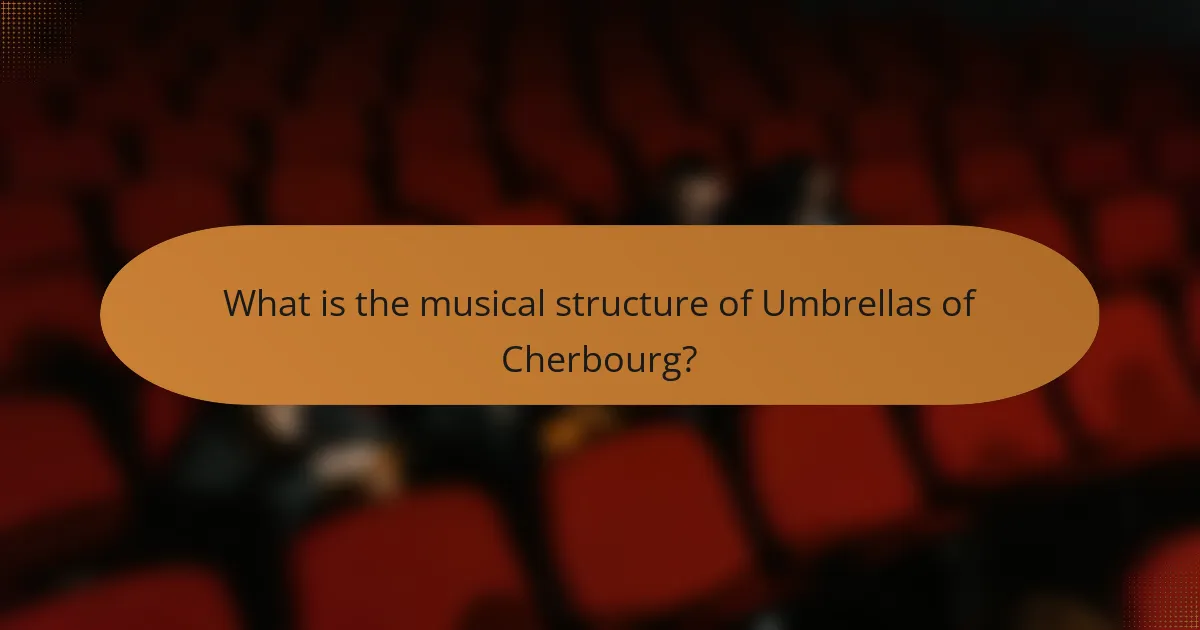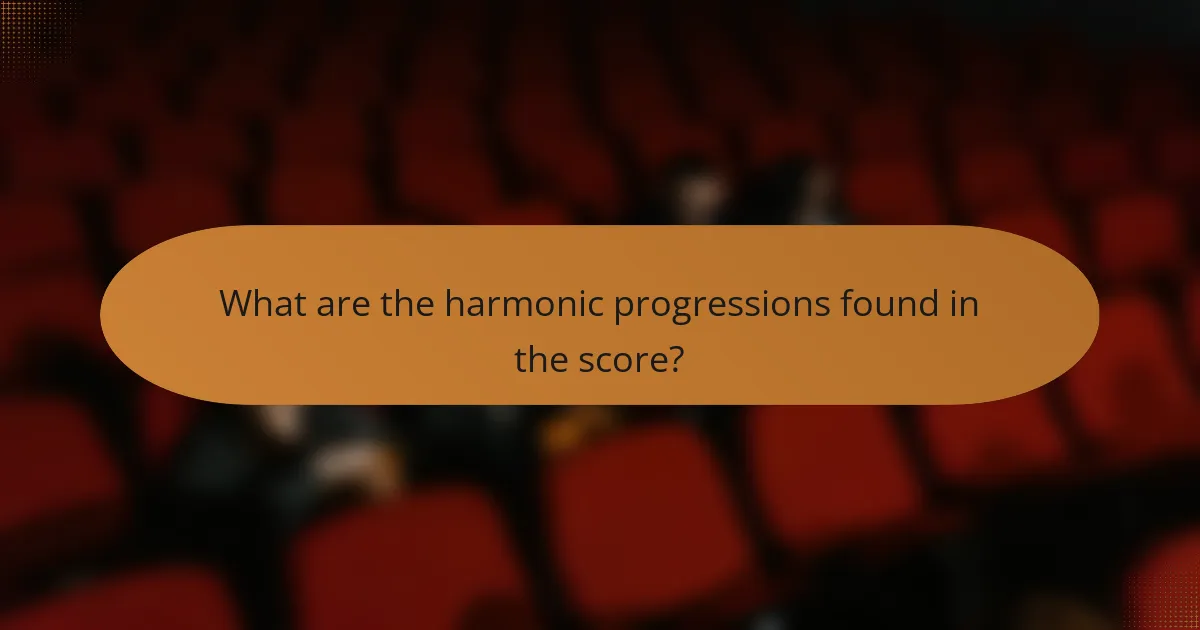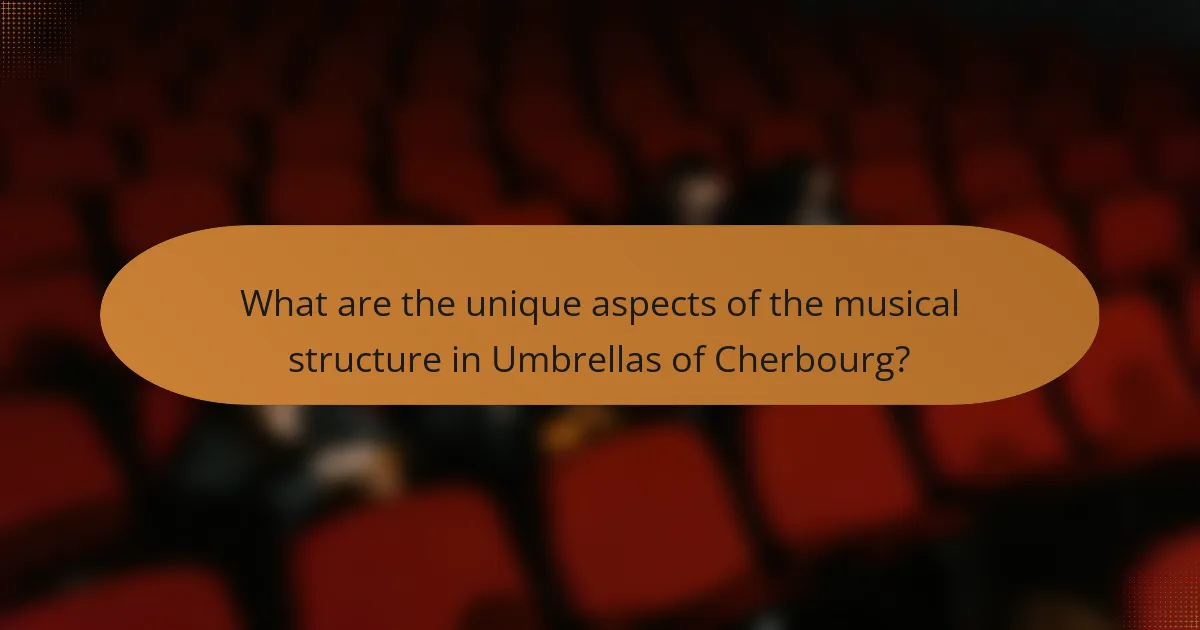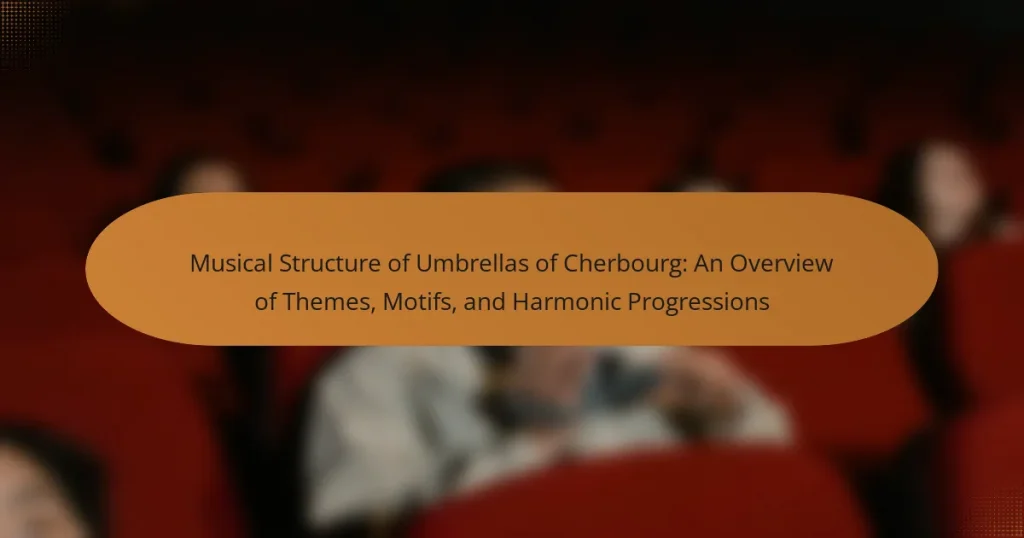The article provides an overview of the musical structure of “Umbrellas of Cherbourg,” a notable sung-through musical featuring a score by composer Michel Legrand. It examines the continuous melodies and sung dialogue that characterize the film, highlighting the seamless transitions between scenes and the emotional connections reinforced by recurring melodic motifs. Key harmonic progressions, such as ii-V-I and I-vi-ii-V, along with the use of chromaticism and modal interchange, contribute to the score’s unique sound. The orchestration blends jazz and pop influences, enhancing the overall narrative and emotional depth of the film. This analysis underscores the innovative elements that make “Umbrellas of Cherbourg” a distinctive example of musical storytelling.

What is the musical structure of Umbrellas of Cherbourg?
The musical structure of “Umbrellas of Cherbourg” is primarily characterized by its use of continuous melodies and a unique form of sung dialogue. The film features a score composed by Michel Legrand, which integrates various musical themes throughout. Each scene transitions seamlessly into the next, maintaining a fluid narrative flow. The harmonic progressions often follow traditional patterns, yet they are enhanced by rich orchestration. The music employs a blend of jazz and pop influences, creating an engaging auditory experience. Melodic motifs recur, reinforcing emotional connections between characters. The overall structure supports the film’s storytelling, making it a notable example of a sung-through musical.
How does the film’s music contribute to its narrative?
The film’s music significantly enhances its narrative by reflecting characters’ emotions and advancing the plot. The score, composed by Michel Legrand, is entirely sung-through, integrating songs with dialogue. This structure immerses viewers in the characters’ internal experiences. Each musical motif corresponds to specific themes, reinforcing emotional connections. For instance, the recurring melody associated with the protagonist expresses longing and nostalgia. The harmonic progressions create tension and resolution, mirroring the story’s dramatic arcs. Additionally, the orchestration complements the visual elements, creating a cohesive storytelling experience. Overall, the music serves as a vital narrative device, shaping audience perceptions and emotional responses.
What are the key musical themes present in the film?
The key musical themes present in the film “The Umbrellas of Cherbourg” include love, longing, and nostalgia. The score prominently features sweeping melodies that evoke emotional depth. A recurring motif represents the main characters’ romantic relationship. This theme evolves throughout the film, reflecting their changing circumstances. Additionally, the use of orchestration enhances the emotional resonance of the music. The film’s songs often blend dialogue and melody seamlessly. This integration helps convey the characters’ inner thoughts and feelings. Overall, the musical themes are integral to the narrative and emotional impact of the film.
How do the themes evolve throughout the film?
The themes in “Umbrellas of Cherbourg” evolve through a progression that mirrors the characters’ emotional journeys. Initially, the film presents themes of youthful love and optimism. As the narrative unfolds, these themes shift to encompass loss and longing. The use of musical motifs reinforces this emotional transition. For instance, the recurring melody associated with Geneviève reflects her initial joy. As her circumstances change, the music becomes more melancholic. This evolution illustrates the complexities of love and the passage of time. The film’s score adapts to the characters’ experiences, enhancing the storytelling. Overall, the thematic evolution is intricately tied to the film’s musical structure.
What motifs are used in the musical score?
The musical score of “The Umbrellas of Cherbourg” features several key motifs. One prominent motif is the recurring use of a waltz rhythm. This rhythm creates a sense of nostalgia throughout the score. Another significant motif is the use of a four-note theme associated with the character Geneviève. This theme is often played in various keys, reflecting her emotional journey. Additionally, the score employs a motif that represents the passage of time, often marked by ascending and descending melodies. These motifs are intricately woven into the fabric of the narrative, enhancing the emotional depth of the film.
How do these motifs represent the characters and their emotions?
Motifs in “Umbrellas of Cherbourg” symbolize the characters’ emotions through their melodic and harmonic qualities. Each motif corresponds to specific characters, reflecting their emotional states. For instance, the main love theme conveys longing and hope, mirroring the protagonists’ desires. In contrast, motifs associated with conflict or separation employ dissonance, highlighting tension and heartbreak. The orchestration of these motifs further enhances emotional depth, using instrumentation to evoke feelings. For example, strings often represent tenderness, while brass may signify urgency or despair. This careful musical structuring aligns closely with the narrative, making the motifs integral to understanding character emotions.
What role do recurring motifs play in the film’s storytelling?
Recurring motifs in the film’s storytelling serve to enhance emotional resonance and thematic continuity. They create a sense of familiarity and connection for the audience. Each motif represents specific emotions or situations, reinforcing character development. For instance, the use of a particular musical theme often accompanies key moments, highlighting their significance. This repetition allows viewers to anticipate emotional shifts, deepening their engagement. Additionally, motifs can symbolize broader themes, such as love and loss, throughout the narrative. Their strategic placement in the film underscores pivotal plot points, guiding audience understanding. Overall, recurring motifs are integral to the film’s narrative structure, enriching the storytelling experience.

What are the harmonic progressions found in the score?
The harmonic progressions found in the score of “Umbrellas of Cherbourg” include several key sequences. Notable progressions are the ii-V-I and I-vi-ii-V sequences. The score often employs chromatic movement and modal interchange. These elements create emotional depth and tension. The use of major and minor seventh chords is prevalent. Additionally, there are frequent shifts between major and minor tonalities. These progressions contribute to the overall unique sound of the musical. The harmonic structure supports the narrative and emotional arcs throughout the score.
How do harmonic progressions enhance the film’s emotional impact?
Harmonic progressions enhance a film’s emotional impact by creating tension and resolution in the music. These progressions guide the audience’s emotional responses throughout the narrative. For instance, dissonant chords can evoke feelings of unease or sadness. Conversely, consonant chords often provide a sense of relief or happiness. In “The Umbrellas of Cherbourg,” specific harmonic choices align with pivotal moments in the storyline. When characters face emotional turmoil, the music reflects this through complex harmonic structures. Research shows that music can significantly influence emotional perception in film. A study by Juslin and Västfjäll (2008) highlights how music evokes emotions by altering the listener’s physiological state. Thus, harmonic progressions serve as a vital tool in shaping the film’s overall emotional landscape.
What specific harmonic techniques are employed by the composer?
The composer employs several specific harmonic techniques in “Umbrellas of Cherbourg.” These include modal interchange, chromaticism, and extended chords. Modal interchange allows the composer to borrow chords from parallel modes, creating unexpected harmonic shifts. Chromaticism introduces notes outside the traditional scale, adding tension and color to the music. Extended chords, such as 7ths and 9ths, enrich the harmonic texture and provide depth. These techniques contribute to the film’s unique emotional landscape and underscore its themes. The use of these techniques is evident in various musical numbers throughout the score.
How do the harmonic choices reflect the film’s themes?
Harmonic choices in “The Umbrellas of Cherbourg” reflect the film’s themes by enhancing emotional depth. The use of chromaticism conveys longing and nostalgia, aligning with the characters’ experiences. Major and minor key shifts illustrate the contrasts between hope and despair. For instance, the transition from major to minor during pivotal scenes underscores the characters’ struggles. The harmonic progressions often mirror the narrative arcs, reinforcing the idea of love’s impermanence. Additionally, the consistent use of unresolved harmonies creates a sense of tension and unresolved emotion. These choices collectively emphasize the film’s exploration of love, loss, and the passage of time.
What is the relationship between themes and motifs in the score?
Themes and motifs in the score of “Umbrellas of Cherbourg” are closely interconnected. Themes represent the main musical ideas, while motifs are shorter, recurring musical phrases. Motifs often help to develop and enhance the themes throughout the score. The relationship allows for emotional depth and cohesion in the narrative. For instance, a motif may encapsulate a character’s feelings, which is then expanded into a theme that reflects broader emotional arcs. This interplay creates a rich musical tapestry that supports the film’s storytelling. The use of motifs to reinforce themes is a common technique in film scores, aiding audience engagement and emotional response.
How do themes and motifs interact to create a cohesive musical narrative?
Themes and motifs interact by providing a framework for musical storytelling. Themes serve as the main ideas or melodies that convey the emotional core of a piece. Motifs are shorter, recurring musical phrases that enhance and elaborate on these themes. Together, they create a cohesive narrative by establishing recognizable patterns and emotional connections. For instance, in “The Umbrellas of Cherbourg,” motifs often reflect the characters’ feelings and situations. This interplay helps to unify the musical experience. The use of motifs to develop themes allows for variation while maintaining a sense of continuity. This technique is essential for guiding the listener through the emotional landscape of the narrative.
What examples illustrate the interplay between themes and motifs?
The interplay between themes and motifs in “The Umbrellas of Cherbourg” is exemplified through the recurring musical phrases and lyrical content. The main theme, associated with love and longing, is presented in various forms throughout the film. For instance, the love theme is introduced during Geneviève’s initial interactions with Guy. This theme is then transformed into a motif that recurs during moments of emotional conflict.
Additionally, the motif of rain symbolizes both separation and connection, reinforcing the central themes of love and loss. As characters face challenges, the rain motif often accompanies variations of the love theme. This relationship between themes and motifs creates a cohesive emotional narrative. The score’s structure effectively intertwines these elements, enhancing the storytelling experience.

What are the unique aspects of the musical structure in Umbrellas of Cherbourg?
The unique aspects of the musical structure in Umbrellas of Cherbourg include its continuous melody and the use of recurring motifs. The film features a sung-through format, where dialogue is delivered through song without spoken lines. This approach creates a seamless flow of music throughout the narrative.
Additionally, the score employs innovative harmonic progressions that enhance the emotional depth of the scenes. The use of chromaticism and unexpected modulations adds complexity to the musical landscape. The orchestration combines strings, woodwinds, and brass to create a rich sound palette.
Moreover, themes associated with the characters are developed and varied throughout the film, reinforcing their emotional arcs. The integration of jazz influences also distinguishes the musical style, contributing to its unique identity. Overall, these elements combine to create a distinctive musical experience that supports the film’s storytelling.
How does the film’s musical style differ from traditional musicals?
The film’s musical style differs from traditional musicals by incorporating continuous dialogue and song. Unlike traditional musicals that separate spoken dialogue from musical numbers, this film blends them seamlessly. Every line of dialogue is sung, creating a unique operatic experience. This approach enhances emotional expression through melody. Additionally, the score features lush orchestration that complements the narrative. The use of recurring motifs reinforces thematic elements throughout the film. This integration of music and storytelling sets it apart from conventional formats. Overall, the film redefines the boundaries of musical storytelling.
What innovative elements does the composer incorporate into the score?
The composer incorporates innovative elements such as continuous musical flow and integration of dialogue with music. This technique creates a seamless narrative experience. The score utilizes unconventional chord progressions, enhancing emotional depth. Unique instrumentation, including synthesizers, adds a modern touch. The composer also employs motifs that evolve throughout the film, reinforcing character development. These elements collectively contribute to a distinctive musical identity. The score’s structure reflects a blend of classical and contemporary styles, showcasing the composer’s versatility.
What practical insights can be gained from analyzing the film’s musical structure?
Analyzing the film’s musical structure reveals insights into emotional storytelling. The integration of music with narrative enhances character development and audience engagement. For example, recurring motifs signify emotional states, allowing viewers to connect with characters deeply. Harmonic progressions reflect changes in mood, aligning music with pivotal plot moments. This technique creates a cohesive experience that reinforces themes of love and loss. The film’s unique use of song as dialogue further emphasizes character emotions and intentions. Understanding these elements can inform filmmakers about effective storytelling through music.
How can understanding the musical structure enhance the viewing experience?
Understanding the musical structure enhances the viewing experience by providing deeper emotional engagement. The musical elements, such as themes and motifs, create a narrative that complements the visual storytelling. For instance, in “Umbrellas of Cherbourg,” specific harmonic progressions underscore pivotal moments. This alignment between music and visuals fosters a more immersive atmosphere. Research shows that music influences viewer emotions and perceptions significantly. A study by Juslin and Vastfjall (2008) indicates that music can evoke strong emotional responses. Therefore, recognizing these musical components allows audiences to appreciate the film’s artistry more fully.
The main entity of the article is the musical structure of “Umbrellas of Cherbourg.” The article provides an overview of the film’s unique musical characteristics, including its continuous melodies, sung dialogue, and innovative harmonic progressions. It explores key themes such as love, longing, and nostalgia, and discusses how recurring motifs enhance character emotions and narrative depth. The analysis highlights the relationship between themes and motifs, illustrating their role in creating a cohesive musical experience that supports the film’s storytelling. Additionally, the article examines the integration of jazz influences and the implications of these musical elements for audience engagement and emotional impact.


